Irish Coinage
____________________
Hammered
Coinage
Irish Hammered Coinage (~995 to ~1660)
The link buttons (if any) at the end of each sub section provide 'drill down' to more detailed information or other related information on the relevant coin issues.
Index:
On this Page :
Related Pages :
©
2003- Copyright
John_Stafford-Langan
Version 1.11a
22 June, 2003
Introduction
'Hammered' is the term given to a type of coin produced in Europe, the Middle East and the New World between about 600 AD and 1700 AD. Hammered coins were made by manually striking a coin blank (usually of silver or gold) between two hand cut dies. The lower die was normally fixed in a wooden block and the upper one struck with a mallet or similar weight.
Hammered coins are normally quite thin, exhibit uneven striking and often have striking cracks at their edges.
Roman and Greek coins
were made using a similar method but they are often
thicker and were probably struck while hot. Despite being
hammered these coins are normally referred to as
'Classical' coins to distinguish them from 'Hammered'
coins.
Hiberno-Norse Coinage ( ~995 AD to ~1150 AD)
Detail Link :
| The
Hiberno-Norse Coinage of Ireland, ~995 to ~1150 (Incomplete) |
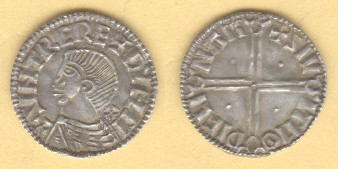
An early
Phase II Hiberno-Norse penny (about 1020 AD)
The first locally produced Irish coinage was the so-called Hiberno-Norse coinage which was first minted in Dublin in about 995 AD under the authority of Sithric III (aka Sithric Silkbeard), the Norse king of Dublin. The early Hiberno-Norse coins were good copies of the English pennies of the period (typically of Aethelred II 979-1016 AD).
The Hiberno-Norse coinage quickly degraded to crude copies of the 'long cross' type of Aethelred and by about 1030 AD they contain minimal legends of vertical strokes instead of letters.
Hiberno Norse - Phase VI - (about
1100 AD)
During the following 100
years the coins became increasingly crude though for the
most part still recognisably inheriting their design from
the 'long cross' coinage. By the early 1100s the coins
were either double or single sided bracteates (thin coins
where the design on one side appears in reverse on the
other) and sometime before the Normans arrival in Ireland
in 1169 production had ceased.
John, as Lord and King ( 1180 to ~1210 )
Detail Link :
| The
Irish Coinage of John, 1180 to ~1210 (incomplete) |
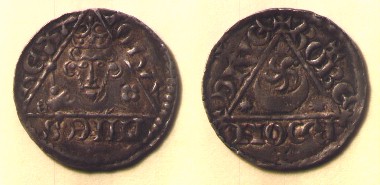
A King
John Penny of Dublin (1200-1205)
The Norman kings of England gradually took over Ireland during the 1170s. John (second son of Henry II) was made Lord of Ireland and struck a coinage of silver halfpennies and farthings in Ireland during the 1180s. These coins were struck in a number of provincial mints as well as in Dublin. During this period John de Courcy set himself up as lord of an area of Eastern Ulster and struck coins in his own name at Carricfergus and Downpatrick.
When he became king John
issued silver pennies, halfpennies and farthings from a
smaller number of mints ceasing production in about 1210
AD. The primary purpose of this coinage was to drain
Ireland of silver (as the coins were of the same standard
as the contemporary English coinage) to support the
French campaigns of the King. There is significant hoard
evidence to suggest that these coins (particularly the
pennies) circulated freely in England and in Europe as
'sterlings'. The halfpennies and farthings are more
likely to have circulated mostly in Ireland as the
English sterling coinage was still mostly dependent on
cutting pennies to make halfpennies and farthings at this
time. No English round farthings (i.e. struck as
farthings not a cut quarter penny) have been found to
date and the number of round halfpennies of this period
is so small compared with the number of pennies to
suggest that the Irish three denomination system was
unique in the sterling world at the time.
Henry III ( 1251 to 1254 )
Detail Link :
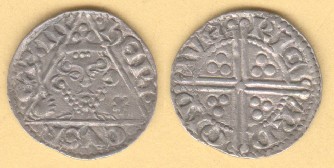
A Henry
III penny of Dublin (1251-1254)
In 1251 Henry III
reopened the Irish mint in Dublin and struck a coinage of
silver pennies. This coinage was also of the same
standard as the contemporary English coinage and very
similar in appearance to it. Again its purpose was to
provide a convenient mechanism for exporting the silver
from Ireland, but in this instance no smaller
denominations were produced to support the local economy.
The success of this mechanism is shown by the fact that
more than 50% of the surviving specimens of this coinage
have been found in European rather than English or Irish
hoards. The great Bruxelles hoard of 1908 contained some
1800 pennies of this type and a further selection of
European copies of the Irish type sterling.
This hoard and the other surviving specimens of this
coinage make it the medieval coinage of which the
greatest percentage of coins struck are known to survive.
It is also supported by a large proportion of the
original accounts of the mint being available to
researchers. And as a result it has helped uncover
significant information about coinage production rates,
die yields and other statistics.
|
|
Edward I (and III) 1276 to ~ 1302 (and 1339)
Detail Links :
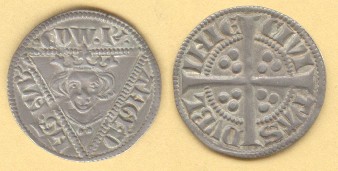
A penny
of Edward I of Dublin (about 1282)
Edward I resumed striking
coins like those of Henry III in Dublin in 1276. However
the issue was short lived and a major recoinage was
started in 1279. The first coinage of Edward I is
represented by only about half a dozen surviving coins.
In an issue of 1279 and in five further issues up to 1302
Edward I produced a high quality coinage for Ireland,
struck at the English standard, of silver pennies,
halfpennies and farthings. As with John's regal issue (~1205)
and Henry III's coinage (1251-1254) the pennies were
destined to be exported from Ireland in large quantities
with a predictable effect on the Irish economy.
Pennies of Edward I of Ireland are relatively common
coins. Of the three mints in operation ; Dublin,
Waterford and Cork, only Cork coins are rare. Two of the
six issues are rare.
The estimate for the total production of coins in Ireland
during this reign is about £50,000 (ref). Being derived from surviving
records and comparison of specimens quantities with those
of English provincial mints. This represents a coinage of
about 12,000,000 pennies (only a very small proportion
being struck into halfpennies and farthings).
Edward III produced a brief coinage for Ireland in 1339. The style was similar to that of Edward I, with a star in the obverse legend as a mint mark. Only two halfpennies are known but it is likely that pennies and farthings were also struck and it is possible that a coin of this very rare issue could be easily confused for an Edward I specimen especially if it is in poor condition.
Henry VI, Edward IV and Richard III ( 1425,1460-1483)
Detail Links :
| Irish
Coinage of Edward IV Part I (1460 to 1470) (incomplete) |
| Irish
Coinage of Edward IV Part II (1470 to 1483) (incomplete) |
| The
Irish Coinage of Richard III (1483 to 1485) (incomplete) |
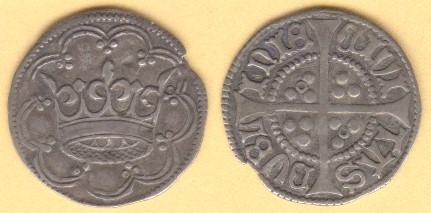
An Early
'Anonymous' Groat of Edward IV - 1460
Henry VI produced a small issue of coins for Ireland in 1425 which is supported by the surviving documentation. There are two pennies in Henry's name which have an annulet initial mark issued in Dublin which are probably specimens of this issue. The annulet issue of Henry VI in England is normally allocated to 1423-1427 further supporting this allocation. However the coinage was certainly known about by numismatists (e.g. Simon 1746) before any specimens were known. The coins are of sterling standard.
As can be seen by the
preceding sections the Irish economy had been subject to
significant export of silver as a result of the English
crown striking Irish silver into coins which could
circulate freely in England. In 1459 in return for
support for his campaign to gain the English crown
Richard Duke of York granted the Irish authorities
permission to strike coins to a lower 'Irish standard'.
Richard won the crown but lost his life! so his eldest
son Edward became Edward IV in 1460.
The following 23 years until Edward's death in 1483 were
witness to a continual struggle between the local Irish
authorities striving to maintain a lower Irish standard,
the King trying to exercise control over coinage struck
in his name which sometime circulated in England (to the
great annoyance of the English merchant class because of
the lower standard) and the unscrupulous activities of a
series of Irish mintmasters.
For numismatists this struggle led to a wonderful series
of coins being produced with a variety of designs, mints,
and standards which are still today being untangled. My
forthcoming paper on this reign will move the confusion
to a higher level!
In short there are six distinct designs. Two of which
have more than one weight standard. There are factions
between Eastern and Southern mints. There are base metal
and billon issues and there are lots of mints (some of
which were illegal, and some of which are still
unrepresented by a surviving coin).
As a final act Edward IV attempted another revision of
the Irish coinage before his death in 1483. But this new
coinage did not emerge until after his death.
Richard III did implement
his brother Edward IV's new coinage (see next section)
but the earliest coins in his name are of the last type
of Edward (with Richard's name often stamped over
Edward's on the die).
Richard III and Henry VII (1483 to 1507)
Detail Links:

A
Geraldine Issue 'Three Crowns' Groat of Henry VII - 1487
Edward IV's last coinage
Act in 1483 was to introduce a new coinage of entirely
Irish design and of a lower standard from the sterling
issues in England. This coinage known as the 'three crown
coinage' was introduced by his brother Richard III after
Edward's death in 1483.
Richard's short reign ended with his death in 1485 and
the three crown coinage was continued by the first of the
Tudor monarchs, Henry VII.
Henry VII persisted with the three crown coinage in
Ireland for some ten years while introducing a more
sophisticated profile coinage in England.
The three crown coinage consisted of groats (fourpence)
halfgroats, pennies and halfpennies. The smaller
denominations being scarce.
In about 1493 Henry VII introduced a new coinage for Ireland consisting almost entirely of groats (fourpence) with a design like that of the earlier English coinage (i.e. a crowned facing portrait obverse and a cross and pellets reverse). This coinage was of a lower standard than the English and the coins were poorly produced.
The portrait issue of
Henry VII survived until about 1500 with the coins being
produced in increasingly poorer quality and in lower
standard silver. By about 1500 the mint in Dublin was
closed and the Irish economy was again dependent on
English coin.
The Tudors and James I (1508 to 1607)
Detail Links :
| Irish
Coinage of Henry VIII (1530 - 1548) (incomplete) |
| Irish
Coinages of Elizabeth I (1558 - 1602) (incomplete) |
Henry VIII the second
Tudor monarch didn't produce a coinage for Ireland until
quite late in his reign. However he was instrumental in
reducing the fineness of the silver coinage of England.
In about 1534 he introduced a coinage of groats and
halfgroats called the harp coinage. These coins are
important in that they carried for the first time the
harp as the symbol of Ireland and in that during this
coinage Henry VIII changed his title for 'Lord of Ireland
(Dominus Hibernie) to King (Rex).
The Harp coinage went through a series of debasements right down to 2 oz fineness (2 ounces of silver in 12 ounces of metal). The coins were struck in London (and later in Bristol).
When Edward VI succeeded
his father he initially struck coins in his father's name
and with his father's portrait including an issue struck
in a newly opened mint in Dublin.
Edward did eventually restore the fineness of the English
currency to sterling, but his last coinage for Ireland
was a continuation of an issue of shillings of the base
type he struck in England. The was the first introduction
of this larger denomination to Ireland.
Mary, during her short solo reign, struck shillings, groats halfgroats and pennies for Ireland, also of a base standard. And after her marriage to Philip of Spain a similar coinage of base shillings and groats was produced.
A Shilling of Elizabeth I's 'Fine Issue' of 1561
Elizabeth initially
followed Mary's coinage with an issue of base shillings
and groats in 1558, but in 1561 she introduced a new
coinage for Ireland of better quality that any since
Henry VI but still below the quality of her English
coinage. This coinage was short lived.
Towards the end of her reign Elizabeth introduced yet
another base coinage for Ireland of shillings, sixpences
and threepences. This coinage was augmented by a slightly
later issue of pennies and halfpennies in copper (the
first token coinage since Edward IV in 1467).
When James I came to the
throne of England he restored the coinage of Ireland to a
better standard with two issues, the first in 1603/04 and
the second in 1604/07. These coinages consisted of
shillings and sixpences. After 1607 the Irish economy was
again dependent on coinage of a purely English type
circulating along with miscellaneous coinages for
elsewhere in Europe. Most of these coins were circulating
at somewhat below their issue weight and would not have
been acceptable to export.
The Great Rebellion and the English Civil War (1640-1650)
Detail Link :
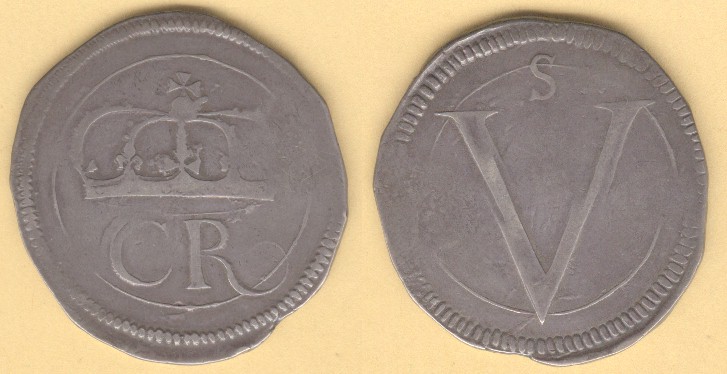
An
Ormond Crown of 1643-44
During the period of the Great Rebellion in Ireland and the English Civil War a number of crudely made local coinages were produced in Ireland, mostly in Dublin.
These coinage were almost exclusively of silver plate cut and struck into a number of denominations with simple patterns including often their weight or value.
Most common among these issues is the 'Ormond Money' issued by the Lord Justice the Earl of Ormond in about 1642-1645 and the Blacksmith's Money which consisted of crude Irish halfcrowns of essentially English design.
Among the rarer issues of
this period are the pistole and double pistole of 1646.
Which are the only gold coins struck in Ireland (excluding
a number of proofs struck in gold over the years and some
recent ecu patterns).